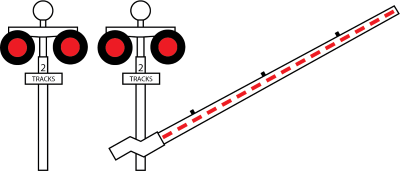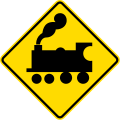A. Wait until they stop flashing, check both ways, then cross
 If the red lights continue to flash at a railway level crossing after the train has passed, what should you do?
If the red lights continue to flash at a railway level crossing after the train has passed, what should you do?
A. Wait until they stop flashing, check both ways, then cross
B. Check both ways. If nothing's coming, then cross
C. Wait for 15 seconds then drive on
If the red lights continue to flash at a railway level crossing after the train has passed you must wait until they have stopped flashing until you cross.
Level crossing signals, which are also called grade crossing signals in some areas, are connected to an electronic device (a 'predictor') connected to a 'feedpoint' which activates them when a train is approaching. As the train approaches it triggers the circuit and the lights and barrier arms are activated as per a predefined interval.
The usual way of activating the lights and barriers is for a small voltage to be applied to the track. Once the train reaches the feedpoint the change in the electrical characteristics triggers the predictor.
If the lights have remained on and you can't see a train it might be that the train has had to slow down or stop temporarily but has still triggered the predictor. Or, a train that has already passed has had to slow down or stop and hasn't terminated the predictor.
Crossings have to be designed to accommodate the potential for trains to have to slow down or stop just before or just after the crossing otherwise wait times can extend into minutes which frustrates motorists.
Around half of New Zealand's railway level crossings have lights, warning bells and/or barrier arms. The other half are uncontrolled.
As you approach an uncontrolled railway crossing, slow down, be prepared to stop, and look both ways up the track before crossing. Uncontrolled crossings will often have a stop sign, and it is then compulsory for you to stop before crossing.
Your first warning of a railway crossing could be your GPS telling you if it has that facility. You will also see this sign:

(check out more signs in this article).
If you are riding a motorbike or bike, mind you don't get your wheels caught in the tracks, and remember that the tracks will be very slippery if it's wet or icy.
If you stall your vehicle on the tracks and it has a manual gearbox you can put it in first gear and use the starter motor to move it forward if it won't start. Don't stay with the vehicle if it won't move; get everyone out and to a safe place and then call emergency services. A train's size can conceal its true speed so at the first sign one is approaching you need to move away from the vehicle as quickly as possible.